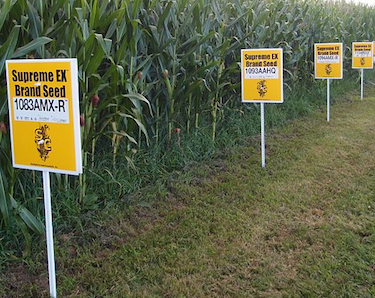
A new study produced by a group of organic farmers and advocacy group Food and Water Watch last week found that a third of U.S. organic farmers had crop contamination on their farms, and more than half of those have had loads of grain rejected by buyers, at a median cost of $4,500 per 1,000 bushels. More than 80% reported they are concerned with the impact of GM crops on their farms. The Food and Water Watch study is an effort to address the conclusions of a 2012 USDA Advisory Committee review, which was criticized as being slanted toward industrial GM farming and the biotech industry.
Organic farmers are burdened with regular testing and certification requirements, and in addition they are required to set aside a buffer zone of about five acres around their fields to guard against GM contamination. This buffer zone alone costs farmers anywhere from $2,500 to $20,000 a year in lost income, according to the new survey. Other farmers wait to plant their crops until after their neighbors' GM crops have pollinated. This delay also imposes a financial burden of several thousand dollars per year. "I'm getting tired of maintaining these miles of buffers," one farmer wrote in response to the new survey. "How about the guy that sprays [herbicide] up to the fence be liable for the damage that is done?" While the Food and Water Watch study focused on the contamination of organic farmers' crops by the genetic material of GM crops during pollination, the quote above makes an important point: that the buffer zones to protect against pollen drift and herbicide drift and runoff penalize organic farmers. Those growing GM crops are free to plant the entire extent of their acreage. The results of this independent study come as the USDA is taking the unusual step of extending the public comment period for its original study on whether GM and non-GM farms can "coexist." Organic farming advocates believe this signals USDA's willingness to listen to their concerns. "Our very strong feeling is that the introduction and propagation of the genetically modified products that are coming out under patent at this point have not had the regulatory oversight that they should have," said Oren Holle, a Kansas farmer and president of the Organic Farmers' Agency for Relationship Marketing, which assisted in the new study's production. "USDA has been extremely lax and, in our opinion, that's due to the excessive influence of the biotech industry in political circles. "It does appear that they're taking a step back. It's our hope that our efforts have at least gained some traction in recognition that all is not well and that they, perhaps, need to do some re-evaluation." To unsubscribe, click here e Wiki | Friends | Editors | Contact Us Copyright © 2014 by Planet Waves, Inc. All Rights Reserved. Other copyrights may apply. Some images used under Fair Use or Share Alike attribution. |
